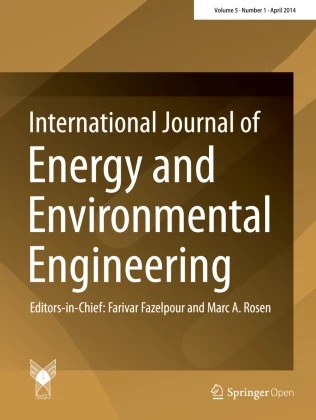Dynamic modeling of a proton exchange membrane fuel cell using chaotic binary shark smell optimizer from electrical and thermal viewpoints
- College of Mechanical and Electrical Engineering, Zhengzhou University of Industrial Technology, Zhengzhou, Henan, 451100, CN

Published in Issue 2022-03-03
How to Cite
Zhao, S., Sun, W., Li, J., & Gong, Y. (2022). Dynamic modeling of a proton exchange membrane fuel cell using chaotic binary shark smell optimizer from electrical and thermal viewpoints. International Journal of Energy and Environmental Engineering, 13(3 (September 2022). https://doi.org/10.1007/s40095-022-00483-8
Abstract
Abstract Proton exchange membrane fuel cells (PEMFC) can be considered as one of the most effective devices in power generation, which converts hydrogen to electrical power directly. The scalability of this system for stationary and mobile utilities is the main advantage of the PEMFC. But still, this technology is not fully mature. Nevertheless, there is a high demand to research in the field of fault detection and monitoring for PEMFC to promote its lifetime and performance and also decrease its operating expenses. Hence, an accurate model for these devices is essential. The accuracy of these models should be sufficient for providing the PEM fuel cell treatment to detect its various internal signals. The present paper aims to model the PEMFC system. The considered fuel cell utilizes the exit temperature in a closed loop. Therefore, the model should provide the thermal and electrical conditions. The Nexa-Ballard fuel cell with the 1.2 kW capacity is regarded here; thus, optimally obtaining the parameters is essential for presenting an accurate behavior. This paper presented four optimization methods in this regard. From these algorithms, the results of three methods are taken from other works, and the chaotic binary shark smell optimizer is suggested here. Eventually, validation of the proposed model by the obtained coefficients is performed using experimental data.Keywords
- Proton exchange membrane fuel cells,
- Parameter identification,
- Chaotic binary shark smell optimizer,
- Thermal and electrical parameters
References
- Hamrang et al. (2020) Performance analysis of a new electricity and freshwater production system based on an integrated gasification combined cycle and multi-effect desalination 12(19) https://doi.org/10.3390/su12197996
- Ahmadi et al. (2021) Performance analysis and limiting parameters of cross-flow membrane-based liquid-desiccant air dehumidifiers (pp. 21-29) https://doi.org/10.1016/j.ijrefrig.2021.09.010
- Puttur et al. (2022) A novel lung-inspired 3D-printed desiccant-coated heat exchanger for high-performance humidity management in buildings https://doi.org/10.1016/j.enconman.2021.115074
- Mehta and Cooper (2003) Review and analysis of PEM fuel cell design and manufacturing 114(1) (pp. 32-53) https://doi.org/10.1016/S0378-7753(02)00542-6
- Wang et al. (2011) A review of polymer electrolyte membrane fuel cells: Technology, applications, and needs on fundamental research 88(4) (pp. 981-1007) https://doi.org/10.1016/j.apenergy.2010.09.030
- Amphlett et al. (1995) Performance modeling of the Ballard Mark IV solid polymer electrolyte fuel cell: I. Mechanistic model development 142(1) https://doi.org/10.1149/1.2043866
- Tao et al. (2005) Modelling and control PEMFC using fuzzy neural networks 6(10) (pp. 1084-1089) https://doi.org/10.1631/jzus.2005.A1084
- Mo et al. (2006) Parameter optimization for a PEMFC model with a hybrid genetic algorithm 30(8) (pp. 585-597) https://doi.org/10.1002/er.1170
- Askarzadeh and Rezazadeh (2011) A grouping-based global harmony search algorithm for modeling of proton exchange membrane fuel cell 36(8) (pp. 5047-5053) https://doi.org/10.1016/j.ijhydene.2011.01.070
- El-Fergany (2018) Electrical characterisation of proton exchange membrane fuel cells stack using grasshopper optimiser 12(1) (pp. 9-17) https://doi.org/10.1049/iet-rpg.2017.0232
- Han et al. (2019) Optimal parameters of PEM fuel cells using chaotic binary shark smell optimizer (pp. 1-15)
- Gouda et al. (2021) Jellyfish search algorithm for extracting unknown parameters of PEM fuel cell models: Steady-state performance and analysis https://doi.org/10.1016/j.energy.2021.119836
- Rosich et al. (2014) On-line model-based fault detection and isolation for PEM fuel cell stack systems 38(11–12) (pp. 2744-2757) https://doi.org/10.1016/j.apm.2013.10.065
- Li et al. (2017) Power management strategy based on adaptive droop control for a fuel cell-battery-supercapacitor hybrid tramway 67(7) (pp. 5658-5670) https://doi.org/10.1109/TVT.2017.2715178
- Han et al. (2017) Multisource coordination energy management strategy based on SOC consensus for a PEMFC–battery–supercapacitor hybrid tramway 67(1) (pp. 296-305) https://doi.org/10.1109/TVT.2017.2747135
- Banan et al. (2015) Combined effects of environmental vibrations and hygrothermal fatigue on mechanical damage in PEM fuel cells 40(4) (pp. 1911-1922) https://doi.org/10.1016/j.ijhydene.2014.11.125
- Massonnat et al. (2014) Multiphysical, multidimensional real-time PEM fuel cell modeling for embedded applications (pp. 554-564) https://doi.org/10.1016/j.enconman.2014.08.062
- Kang and Min (2016) Dynamic simulation of a fuel cell hybrid vehicle during the federal test procedure-75 driving cycle (pp. 181-196) https://doi.org/10.1016/j.apenergy.2015.09.093
- Haddad et al. (2015) Nonlinear time-variant model of the PEM type fuel cell for automotive applications (pp. 31-44) https://doi.org/10.1016/j.simpat.2014.11.002
- Methekar et al. (2007) Dynamic analysis and linear control strategies for proton exchange membrane fuel cell using a distributed parameter model 165(1) (pp. 152-170) https://doi.org/10.1016/j.jpowsour.2006.11.047
- Kunusch et al. (2008) Linear identification and model adjustment of a PEM fuel cell stack 33(13) (pp. 3581-3587) https://doi.org/10.1016/j.ijhydene.2008.04.052
- Li et al. (2008) Identification of the Hammerstein model of a PEMFC stack based on least squares support vector machines 175(1) (pp. 303-316) https://doi.org/10.1016/j.jpowsour.2007.09.049
- Buchholz and Krebs (2007) Dynamic modelling of a polymer electrolyte membrane fuel cell stack by nonlinear system identification 7(5) (pp. 392-401) https://doi.org/10.1002/fuce.200700013
- Wang et al. (2005) Dynamic models and model validation for PEM fuel cells using electrical circuits 20(2) (pp. 442-451) https://doi.org/10.1109/TEC.2004.842357
- Restrepo et al. (2014) Identification of a proton-exchange membrane fuel cell’s model parameters by means of an evolution strategy 11(2) (pp. 548-559) https://doi.org/10.1109/TII.2014.2317982
- Salim et al. (2015) The parameter identification of the Nexa 1.2 kW PEMFC’s model using particle swarm optimization (pp. 26-34) https://doi.org/10.1016/j.renene.2014.10.012
- Pérez-Navarro (2016) Experimental verification of hybrid renewable systems as feasible energy sources (pp. 384-391) https://doi.org/10.1016/j.renene.2015.08.030
- Ye et al. (2009) Parameter identification for proton exchange membrane fuel cell model using particle swarm optimization 34(2) (pp. 981-989) https://doi.org/10.1016/j.ijhydene.2008.11.026
- Sun et al. (2015) Parameter identification of PEMFC model based on hybrid adaptive differential evolution algorithm (pp. 1334-1341) https://doi.org/10.1016/j.energy.2015.06.081
- Abedinia et al. (2016) A new metaheuristic algorithm based on shark smell optimization 21(5) (pp. 97-116) https://doi.org/10.1002/cplx.21634

 10.1007/s40095-022-00483-8
10.1007/s40095-022-00483-8











